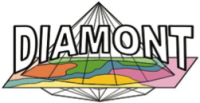This is an old revision of the document!
Table of Contents
DIAMONT

Data Infrastructure of the Alps - Mountain Orientated Network Technology
- AS priority area: Accessibility and Connectivity
- Duration: 03/2005 - 03/2008
Project partners
- Lead partner: Institute of Geography, University of Innsbruck (AT) Contact person: Axel Borsdorf, Tel.: + 43 512 507 5400, axel.borsdorf@uibk.ac.at
- European Academy of Bozen/Bolzano (EURAC), Institute for Alpine Environment (IT) Contact person: Ulrike Tappeiner, Tel.: +39 (0) 471 055 301, ulrike.tappeiner@eurac.edu
- Anton Melik Geographical Institute, Scientific Research Centre of the Slovenian Academy of Sciences and Arts (SI) Contact person: Drago Perko, Tel.: +38 61 4706 360, drago@zrc-sazu.si
- Bosch & Partner GmbH (DE) Contact person: Konstanze Schönthaler, Tel.: +49 89 2355 5852
- irstea Unité de Recherche Dévelopment des Territoires Montagnards (FR) Contact person: Vincent Briquel, Tel.: +33 4 7676 2751, vincent.briquel@grenoble.cemagref.fr
- ifuplan Institut für Umweltplanung, Landschaftsplanung und Naturschutz (DE) Contact person: Stefan Marzelli, Tel.: +49 89 307 4975 10, stefan.marzelli@ifuplan.de
- UNCEM Unità Nazionale Comuni e Enti Montani (IT) Contact person: Marco Zumaglini, uncem.nazionale@uncem.net
- Forschungsstelle für Wirtschaftsgeographie und Raumordnungspolitik (CH) Contact person: Martin Boesch, Tel.: +41 71 224 2582, martin.boesch@unisg.ch
Project summary
DIAMONT worked in the field of sustainable regional development in the Alps. The project provided expert assistance to the Permanent Secretariat of the Alpine Convention in Innsbruck with the review and implementation of the pan-Alpine information system SOIA (System for Observation and Information of the Alps). DIAMONT elaborated harmonised data and relevant indicators to monitor the sustainable development of the Alpine regions. This process involved the testing of pilot tools for regional development and discussions with the population in test regions. It also analysed the planning milieu and experts expectations on alpine development, made an inquiry among mayors. Besides 3 databases on hard data on NUTS5 level and qualitative data on steering instruments and best practices it published an Atlas of the Alps in five languages.
Hypotheses
Keywords
Topics
Project results
| Result | Category | Language(s) | Target group | Remark |
|---|---|---|---|---|
| Atlas of the Alps: Mapping the Alps | Other | EN, IT, FR, SI, DE, AT | Civil society / citizen | The Alps are the largest and most significant high mountain area in Europe and the starting point for numerous debates on transit traffic, climate change, tourist trends or the impact of a global market economy, to name but a few. What has been lacking so far is a sound basis of cross-national data, as well as comparative maps generated from such a basis. Editors Ulrike Tappeiner, Axel Borsdorf and Erich Tasser, together with well-known experts and practitioners from the respective nation states, were thus confronted with the task of compiling an up-to-date and solid basis of information that would support stakeholders from the fields of research, politics and the economy in dealing with issues and decisions involving the Alpine region. This is how Mapping the Alps came about. It contains more than 100 four-colour, pan-Alpine maps on social, economic, and environmental aspects, presented in an intuitive format with concise interpretations in German, French, Italian, Slovenian, and English. |
| DIAMONT Database | Data | EN | Scientists | For the DIAMONT database a DIAMONT teaching tool has been elaborated in the FP 7 project mountain.TRIP |